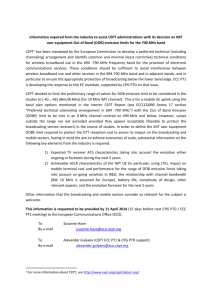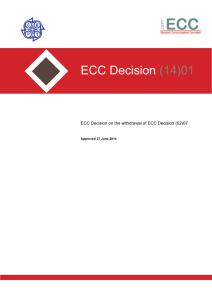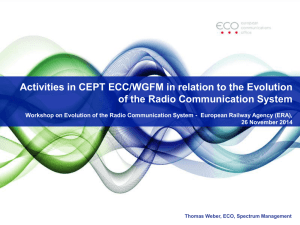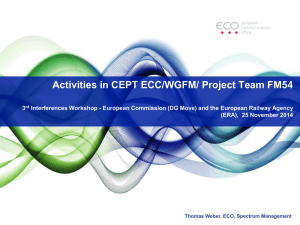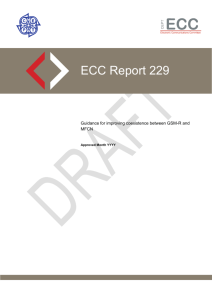ELECTRONIC COMMUNICATIONS COMMITTEE
advertisement
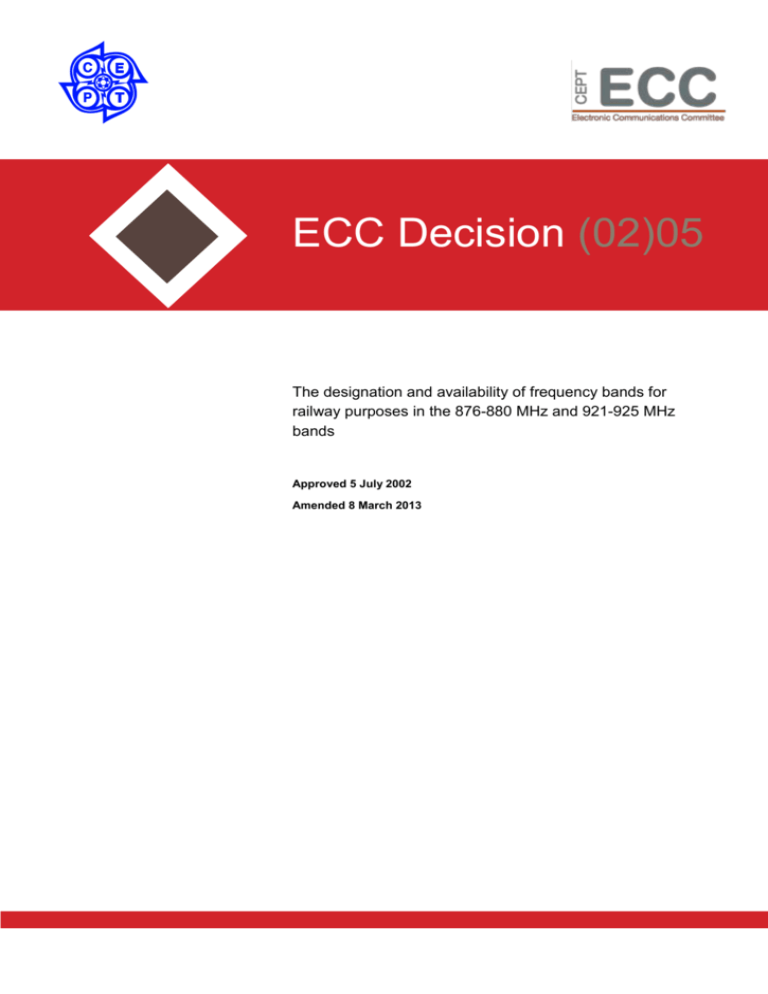
ELECTRONIC COMMUNICATIONS COMMITTEE ECC Decision (02)05 The designation and availability of frequency bands for railway purposes in the 876-880 MHz and 921-925 MHz bands Approved 5 July 2002 Amended 8 March 2013 ECC/DEC/(02)05 Page 2 EXPLANATORY MEMORANDUM 1 INTRODUCTION This ECC Decision addresses the designation of the bands 876.0-880.0 MHz and 921.0-925.0 MHz which are used for railway operational applications on a European wide basis. These systems support railway operations and especially those in accordance with the Directive 2008/57/EC of the European Parliament and of the Council on the Interoperability of the rail system and the Commission Decision 2012/88/EU on the technical specification for interoperability relating to the control-command and signalling subsystems of the trans-European rail system. 2 BACKGROUND This ECC Decision covers exclusively the designation and especially the availability of frequency bands for duplex operation and frequency planning for railways. This means the relevant bands should be designated in the national frequency usage tables and should be made available by the administrations. As the railway equipment currently on the market is designed to cover the frequency bands 876-915 MHz and 921-960 MHz, additional designations may be made on a national basis. Possibility for a GSM-R extension on a national basis into the bands 873-876 MHz and 918-921 MHz is given in ECC/DEC/(04)06 on the availability of frequency bands for the introduction of Wide Band Digital Land Mobile PMR/PAMR in the 400 MHz and 800/900 MHz bands. The current software controlled radio equipment technology offers the flexibility with regard to different frequency availability situations within the CEPT member countries, which allows easily a European frequency planning. To achieve the aim of taking a new step towards harmonisation and implementation of frequency spectrum for Railway Operational Applications, it has been decided to develop this Decision. The harmonisation on a European Basis would ease the implementation of Directives 1999/5/EC (the R&TTE Directive) and 2008/57/EC (Interoperability of the rail system), and Commission Decision 2012/88/EU (technical specification for interoperability relating to the control-command and signalling subsystems of the trans-European rail system). 3 REQUIREMENT FOR AN ECC DECISION The allocation or designation of frequency bands for use by a service or system under specified conditions in CEPT member countries is laid down by law, regulation or administration action. It is considered necessary to designate and implement frequency bands for Railway Operational systems. Only the real availability of an appropriate amount of radio spectrum and not only the designation within the national frequency usage tables encourage manufacturers and operators to make the necessary investments in this radio communication technology. A commitment by CEPT member countries to implement an ECC Decision will provide a clear indication that the required frequency bands will be made available on time and on a European-wide basis. ECC/DEC/(02)05 Page 3 ECC DECISION OF 5 JULY 2002, AMENDED 26 JUNE 2009, AMENDED 9 DECEMBER 2011, AMENDED 8 MARCH 2013 ON THE DESIGNATION AND AVAILABILITY OF FREQUENCY BANDS FOR RAILWAY PURPOSES IN THE 876-880 MHz AND 921-925 MHz BANDS (ECC/DEC/(02)05) “The European Conference of Postal and Telecommunications Administrations, considering a) that railway organisations are making increasingly extensive use of radiocommunications to facilitate the managing and operating of railway traffic and increase its safety; especially in accordance with the European Rail Traffic Management System (ERTMS) and the Directive 2008/57/EC of the European Parliament and of the Council; b) that it is essential to be able to use common railway radio equipment in different countries in a common frequency band as well as for border crossing traffic; c) that the advanced frequency economic digital radio system developed by the International Union of Railways (“Union Internationale des Chemins de fer” (UIC)) should cover the international requirements without excluding national requirements for non-public radiocommunication of the railways and has replaced most of the current analogue systems; d) that the amount of frequency spectrum required for railway purposes is different in different countries; e) that the introduction by the railways of this radio system will liberate frequencies presently used by railways; f) that multilateral/bilateral agreements on frequency coordination in border areas can have an influence on the availability of radio spectrum; g) that European-wide harmonised use of frequencies would ease the implementation of Directive 1999/5/EC (the R&TTE Directive); h) that the bands 873.0-876.0 MHz / 918.0-921.0 MHz may be used on a national basis as extension bands for GSM-R as described in ECC Decision (04)06; i) that ECC Report 162 on "Practical mechanism to improve the compatibility between GSM-R and public mobile networks and guidance on practical coordination" may be considered by administrations and/or operators to address interference cases between GSM-R and public mobile networks on a local/regional/national basis, taking into account the operational aspects; j) that guard spectrum of 200 kHz may be required between GSM-R in the bands 876.0 - 880.0 MHz / 921.0 - 925.0 MHz and Mobile/Fixed Communications Networks (MFCN) in the bands 880.0 - 915.0 / 925.0 - 960.0 MHz; k) that GSM-R equipment complies with the harmonised European standards EN 301 502 (base stations) or EN 301 511 (mobile stations); l) that ETSI has developed and published TS 102 933-1 and TS 102 933-2 on improved GSM-R receiver parameters; m) that ERC Recommendation ERC/REC 74-01 defines unwanted emission limits in the spurious domain for radio communication equipment; n) that the systems operate in 200 kHz (within the GSM-R network) channel spacing; o) that administrations have the right to exercise frequency management which may affect the number of service suppliers, in conformity with their international trade obligations and to European Community legislation as far as EU Member States are concerned; p) that allocation, assignment and technical co-ordination of frequencies must be done in an objective, timely, impartial, transparent and non-discriminatory manner, and should not be more burdensome than necessary under international rules, in particular, to ensure the efficient use of frequency spectrum; q) that in EU/EFTA countries the radio equipment that is under the scope of this Decision shall comply with the R&TTE Directive (1999/5/EC). Conformity with the essential requirements of the R&TTE Directive may be demonstrated by compliance with the applicable harmonised European standard(s) or by using the other conformity assessment procedures set out in the R&TTE Directive. ECC/DEC/(02)05 Page 4 DECIDES 1. that CEPT administrations shall designate and make available the frequency bands 876.0-880.0 MHz and 921.0-925.0 MHz for railway purposes; 2. that the frequency requirements for international and national railway operations shall be met within the bands; 876.0-880.0 MHz (mobile station transmit) paired with 921.0-925.0 MHz (base station transmit) with a duplex separation of 45 MHz for duplex operation as shown in Annex 1. 3. that this Decision enters into force on 8 March 2013; 4. that the preferred date for implementation of this Decision shall be 8 September 2013; 5. that CEPT administrations shall communicate the national measures implementing this Decision to the ECC Chairman and the Office when this ECC Decision is nationally implemented.” Note: Please check the Office documentation database http://www.ecodocdb.dk for the up to date position on the implementation of this and other ECC Decisions. ECC/DEC/(02)05 Page 5 ANNEX 1 Frequency arrangement for GSM-R stations Centre Frequency Mobile Tx (MHz) 876.2000 876.4000 876.6000 876.8000 877.0000 877.2000 877.4000 877.6000 877.8000 878.0000 878.2000 878.4000 878.6000 878.8000 879.0000 879.2000 879.4000 879.6000 879.8000 Centre Frequency Base Tx (MHz) 921.2000 921.4000 921.6000 921.8000 922.0000 922.2000 922.4000 922.6000 922.8000 923.0000 923.2000 923.4000 923.6000 923.8000 924.0000 924.2000 924.4000 924.6000 924.8000


